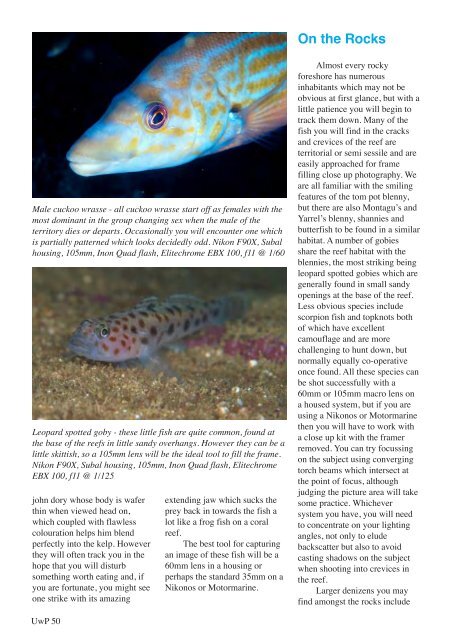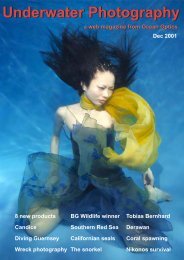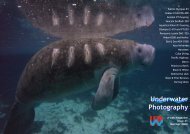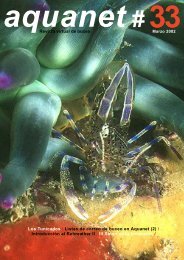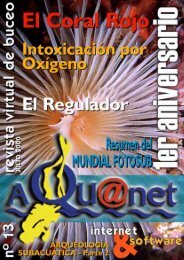Underwater Photography Underwater Photography
Underwater Photography Underwater Photography
Underwater Photography Underwater Photography
You also want an ePaper? Increase the reach of your titles
YUMPU automatically turns print PDFs into web optimized ePapers that Google loves.
On the Rocks<br />
Male cuckoo wrasse - all cuckoo wrasse start off as females with the<br />
most dominant in the group changing sex when the male of the<br />
territory dies or departs. Occasionally you will encounter one which<br />
is partially patterned which looks decidedly odd. Nikon F90X, Subal<br />
housing, 105mm, Inon Quad flash, Elitechrome EBX 100, f11 @ 1/60<br />
Leopard spotted goby - these little fish are quite common, found at<br />
the base of the reefs in little sandy overhangs. However they can be a<br />
little skittish, so a 105mm lens will be the ideal tool to fill the frame.<br />
Nikon F90X, Subal housing, 105mm, Inon Quad flash, Elitechrome<br />
EBX 100, f11 @ 1/125<br />
john dory whose body is wafer<br />
thin when viewed head on,<br />
which coupled with flawless<br />
colouration helps him blend<br />
perfectly into the kelp. However<br />
they will often track you in the<br />
hope that you will disturb<br />
something worth eating and, if<br />
you are fortunate, you might see<br />
one strike with its amazing<br />
extending jaw which sucks the<br />
prey back in towards the fish a<br />
lot like a frog fish on a coral<br />
reef.<br />
The best tool for capturing<br />
an image of these fish will be a<br />
60mm lens in a housing or<br />
perhaps the standard 35mm on a<br />
Nikonos or Motormarine.<br />
Almost every rocky<br />
foreshore has numerous<br />
inhabitants which may not be<br />
obvious at first glance, but with a<br />
little patience you will begin to<br />
track them down. Many of the<br />
fish you will find in the cracks<br />
and crevices of the reef are<br />
territorial or semi sessile and are<br />
easily approached for frame<br />
filling close up photography. We<br />
are all familiar with the smiling<br />
features of the tom pot blenny,<br />
but there are also Montagu’s and<br />
Yarrel’s blenny, shannies and<br />
butterfish to be found in a similar<br />
habitat. A number of gobies<br />
share the reef habitat with the<br />
blennies, the most striking being<br />
leopard spotted gobies which are<br />
generally found in small sandy<br />
openings at the base of the reef.<br />
Less obvious species include<br />
scorpion fish and topknots both<br />
of which have excellent<br />
camouflage and are more<br />
challenging to hunt down, but<br />
normally equally co-operative<br />
once found. All these species can<br />
be shot successfully with a<br />
60mm or 105mm macro lens on<br />
a housed system, but if you are<br />
using a Nikonos or Motormarine<br />
then you will have to work with<br />
a close up kit with the framer<br />
removed. You can try focussing<br />
on the subject using converging<br />
torch beams which intersect at<br />
the point of focus, although<br />
judging the picture area will take<br />
some practice. Whichever<br />
system you have, you will need<br />
to concentrate on your lighting<br />
angles, not only to elude<br />
backscatter but also to avoid<br />
casting shadows on the subject<br />
when shooting into crevices in<br />
the reef.<br />
Larger denizens you may<br />
find amongst the rocks include<br />
UwP 50


